Distribution Pattern of Fish Richness in the Yarlung Zangbo River Basin
Abstract
1. Introduction
2. Materials and Methods
2.1. Study Area
2.2. Sample Collection
2.3. “Drainage–Range Overlap” Distribution of Fish
2.4. Species Richness Distribution Patterns
| Scientific Names | IUCN Red List 1 | Non-Native Fish 2 | Reference | |
|---|---|---|---|---|
| I. | Cypriniformes | |||
| i. | Cyprinidae | |||
| 1 | Abbottina rivularis | LC | * | [7,30,37,38] |
| 2 | Aristichthys nonilis | * | [7,30,31,37] | |
| 3 | Bangana dero | LC | [13,14,29,31,39,40,41] | |
| 4 | Barbodes hexagonlepis | [29,31,39,40,41] | ||
| 5 | Carassius auratus | LC | * | [13] |
| 6 | Carassius auratus | * | [7,15,30,31,39,42,43] | |
| 7 | Carassius auratus gibelio | [30,43] | ||
| 8 | Ctenopharyngodon idella | LC | * | [7,30,31,37] |
| 9 | Cyprinus carpio | VU | * | [7,13,15,29,30,31,37] |
| 10 | Garra kempi | LC | [44] | |
| 11 | Garra motouensis | [13] | ||
| 12 | Garra tibetana | [13,29,31,45] | ||
| 13 | Garra yajiangensis | [13] | ||
| 14 | Gymmocypris chui | [7,40,41,46] | ||
| 15 | Gymmocypris scleracanthus | [46,47] | ||
| 16 | Gymnocypris namensis | [39,42] | ||
| 17 | Gymnocypris waddelli | [7,41,46] | ||
| 18 | Hypophthalmichthys molitrix | NT | * | [7,30] |
| 19 | Oxygymnocypris stewartii | NT | [7,12,13,14,15,24,30,31,39,41,42,43,46,47,48,49,50] | |
| 20 | Pseudorasbora parva | LC | * | [7,13,15,29,30,31,37,39,41,42,43] |
| 21 | Ptychobarbus dipogon | LC | [7,12,13,14,15,24,25,30,31,38,39,40,42,43,46,47,48,49,50,51,52] | |
| 22 | Ptychobarbus kaznakovi | [39,42,46] | ||
| 23 | Schizopygopsis younghusbandi | DD | [7,12,13,14,15,24,30,31,38,39,41,42,43,46,47,48,49,50,53,54,55] | |
| 24 | Schizothorax curvilabiatus | DD | [13,14,15,24,29,31,39,41,44,47] | |
| 25 | Schizothorax labiata | [14,29,39,40,41] | ||
| 26 | Schizothorax lissolabiatus | LC | [40] | |
| 27 | Schizothorax macropogon | NT | [13,14,30,31,47] | |
| 28 | Schizothorax molesworthi | DD | [13,14,24,24,29,31,39,40,41,41,44,56] | |
| 29 | Schizothorax oconnori | LC | [12,13,30,31,47,50,57] | |
| 3 | Schizothorax plagiostomus | VU | [25,27,28,40] | |
| 31 | Schizothorax waltoni | LC | [7,13,14,15,24,27,28,30,31,39,40,41,42,43,46,47,49,50,51,57,58] | |
| ii. | Psilorhynchidae | |||
| 32 | Psilorhynchus homaloptera | LC | [13,14,24,25,29,31,39,40,41,59] | |
| iii. | Nemacheilidae | |||
| 33 | Aborichthys kempi | NT | [14,24,39,40,41] | |
| 34 | Nemacheilus subfuscus | [14,24,25,29,31,39,40,41,56] | ||
| 35 | Neolissochilus hexagonolepis | NT | [13,44] | |
| 36 | Schistura scaturigina | LC | [13] | |
| 37 | Triplophysa aliensis | [40] | ||
| 38 | Triplophysa brevicauda | [12,13,14,31,39,41,43,46,48,53,60] | ||
| 39 | Triplophysa microps | LC | [7,14,15,39,40,46] | |
| 40 | Triplophysa orientalis | LC | [7,14,24,30,31,39,40,42,43,46,48,53,60] | |
| 41 | Triplophysa stenura | LC | [7,12,13,14,15,24,30,39,40,42,43,48,53,56] | |
| 42 | Triplophysa stewarti | LC | [7,13,14,24,28,30,39,40,42,43,46,48,49,53,60] | |
| 43 | Triplophysa stoliczkai | [12,13,27,31,40,41,43,46,48] | ||
| 44 | Triplophysa tibetana | LC | [7,13,14,15,24,30,31,39,40,42,43,46,48,53] | |
| iv. | Cobitidae | |||
| 45 | Misgurnus anguillicaudatus | LC | * | [13,30,39,42,43] |
| 46 | Paramisgurnus dabryanus | * | [13,30,31,39,41,42] | |
| II. | Siluriformes | |||
| v. | Sisoridae | |||
| 47 | Exostoma labiatum | LC | [13,14,24,26,29,39,40,41,44,52,56,61] | |
| 48 | Exostoma tenuicaudata | [13] | ||
| 49 | Glaridoglanis andersonii | DD | [13,14,15,24,26,29,31,39,40,41,62] | |
| 50 | Glyptosternum maculatum | [7,14,15,24,26,31,39,40,41,42,43,46,48,50,62,63,64] | ||
| 51 | Glyptothorax annandalei | LC | [13,14,24,26,29,31,39,40,41,62] | |
| 52 | Glyptothorax gracilis | [13,14,25,39,40,41] | ||
| 53 | Parachiloglanis hodgarti | LC | [13,14,24,26,29,31,39,40,41,62] | |
| 54 | Pareuchiloglanis kamengensis | [14,15,24,26,29,31,39,40,41,56,62,65] | ||
| 55 | Pseudecheneis sulcata | LC | [7,13,14,15,24,26,29,30,31,39,41,56,62,66,67,68] | |
| vi. | Siluridae | |||
| 56 | Siulrus asotus | * | [7,30,31,43] | |
| III. | Perciformes | |||
| vii. | Odontobutidae | |||
| 57 | Micropercops swinhonis | LC | * | [7,13,30,31,37,39,42,43] |
| 58 | Perccottus glenii | LC | * | [31] |
| viii. | Channidae | |||
| 59 | Channa argus | LC | * | [30,31] |
| ix. | Cichlidae | |||
| 60 | Oreochromis mossambicus | VU | * | [30,31] |
| IV. | Synbranchiformes | |||
| x. | Synbranchidae | |||
| 61 | Monopterus albus | LC | * | [31] |
3. Results
3.1. Species Composition
3.2. Distribution Patterns of Fish Species
3.3. Relationships between Fish Richness and Environmental Factors
4. Discussion
4.1. Fish Distribution Pattern in the Yarlung Zangbo River
4.2. Relationship between Climate Factors and Fish Richness Distribution
4.3. Conclusions
Author Contributions
Funding
Institutional Review Board Statement
Data Availability Statement
Acknowledgments
Conflicts of Interest
References
- LuoZhu, N.; Wang, J.Q.; Xu, X.Y. Zoning for Effective Utilization of Agricultural Water Resources Based on Principal Component Analysis and Fuzzy C-Means Clustering Algorithm. Chin. J. Hydrol. 2011, 31, 76–79. [Google Scholar] [CrossRef]
- Matthews, W.J. Fish Faunal “Breaks” and Stream Order in the Eastern and Central United States. Environ. Biol. Fishes 1986, 17, 81–92. [Google Scholar] [CrossRef]
- Vörösmarty, C.J.; McIntyre, P.B.; Gessner, M.O.; Dudgeon, D.; Prusevich, A.; Green, P.; Glidden, S.; Bunn, S.E.; Sullivan, C.A.; Liermann, C.R.; et al. Global Threats to Human Water Security and River Biodiversity. Nature 2010, 467, 555–561. [Google Scholar] [CrossRef] [PubMed]
- Ma, B.S.; Wang, S.B.; Shao, J.; Li, D.P.; Xie, C.X.; Liu, X.J.; Huo, B. Population resources and fishery conversation policies of Schizothorax oconnori in the Yarlung Zangbo River. J. Fish. Sci. China 2020, 27, 106–117. [Google Scholar] [CrossRef]
- Hu, G.; Du, X.; Chen, L.; Ji, F.; Mu, Z.B.; Ma, B.; Li, L.; Jing, X. Current Situation, Major Problems and Countermeasures of Fishery Resources in Xizang Autonomous Region. Chin. J. Fish. 2019, 32, 68–72. [Google Scholar] [CrossRef]
- Liu, H.; Mu, Z.; Cai, B.; Zhang, B.; Zhou, J.; Zhang, C.; Pan, Y.; Chen, M. Coupling Supply-Side Structural Reform and Technological Innovation Boosting the Fishery Resource Conservation Process in Tibet. J. Lake Sci. 2018, 30, 266–278. [Google Scholar] [CrossRef][Green Version]
- Yang, H.Y.; Huang, D.M. A Preliminary Investigation on Fish Fauna and Resources of the Upper and Middle Yalu Tsangpo River. J. Cent. China Norm. Univ. (Nat. Sci.) 2011, 45, 629–633. [Google Scholar] [CrossRef]
- Liu, S.Z.; Fan, J.R.; Zhu, P.Y.; Wen, A.B.; Zhou, L. Cause analysis of environmental hazards in the middle reaches of Yaluzangbn River in Tibet. J. Nat. Disasters 2001, 10, 25–30. [Google Scholar]
- Zhang, S.; Ga, L.; He, Y.P. Some thoughts on the Development of Fisheries in Nyingchi, Tibet. Chin. Aquat. Prod. 2011, 4, 31–32. [Google Scholar] [CrossRef]
- Xing, Y.C.; Zhang, C.G.; Fan, E.Y.; Zhao, Y.H. Freshwater Fishes of China: Species Richness, Endemism, Threatened Species and Conservation. Divers. Distrib. 2016, 22, 358–370. [Google Scholar] [CrossRef]
- Liu, H.P.; Liu, Y.C.; Liu, S.Y.; Song, X.G.; CiRen, L.J.; Liu, M.J.; Liu, L.L.; Rao, C.W. Fecundity and Reproductive Strategy of Ptychobarbus Dipogon. Acta Hydrobiol. Sin. 2018, 42, 1169–1179. [Google Scholar] [CrossRef]
- Deng, J.; Dong, D.H.; Zhang, H.X.; Jiang, W.; Zhao, H.; Kong, F.; Xu, T.; Wang, Q. Investigation and Diversity Analysis of Fish Resources in the Dogxung Zangbo Basin of the Yalu Tsangpo River. Genom. Appl. Biol. 2020, 39, 3468–3474. [Google Scholar] [CrossRef]
- Liu, F.; Li, M.Z.; Wang, J.; Gong, Z.; Liu, M.; Liu, H.Z.; Lin, P. cheng Species Composition and Longitudinal Patterns of Fish Assemblages in the Middle and Lower Yarlung Zangbo River, Tibetan Plateau, China. Ecol. Indic. 2021, 125, 107542. [Google Scholar] [CrossRef]
- Fisheries Bureau of the Tibet Autonomous Region. Fish and Fish Resources in Xi Zang, China; Fisheries Bureau of the Tibet Autonomous Region: Xi Zang, China, 1995. [Google Scholar]
- Zhou, J.; Lai, J.S.; Du, J.; Liu, G.; Zhao, G.; Lin, J.; Wu, M.S.; Liu, Y. Investigation and Protection Countermeasures of Fish Resources in Nyingchi Prefecture. Southwest China J. Agric. Sci. 2010, 23, 938–942. [Google Scholar] [CrossRef]
- Zambrano, L.; Martínez-Meyer, E.; Menezes, N.; Peterson, A.T. Invasive Potential of Common Carp (Cyprinus carpio) and Nile Tilapia (Oreochromis niloticus) in American Freshwater Systems. Can. J. Fish. Aquat. Sci. 2006, 63, 1903–1910. [Google Scholar] [CrossRef]
- Pont, D.; Hugueny, B.; Oberdorff, T. Modelling Habitat Requirement of European Fishes: Do Species Have Similar Responses to Local and Regional Environmental Constraints? Can. J. Fish. Aquat. Sci. 2005, 62, 163–173. [Google Scholar] [CrossRef]
- Field, R.; Hawkins, B.A.; Cornell, H.V.; Currie, D.J.; Diniz-Filho, J.A.F.; Guégan, J.-F.; Kaufman, D.M.; Kerr, J.T.; Mittelbach, G.G.; Oberdorff, T.; et al. Spatial Species-Richness Gradients across Scales: A Meta-Analysi. J. Biogeogr. 2009, 36, 132–147. [Google Scholar] [CrossRef]
- Huston, M.A. Local Processes and Regional Patterns: Appropriate Scales for Understanding Variation in the Diversity of Plants and Animals. Oikos 1999, 86, 393–401. [Google Scholar] [CrossRef]
- Griffiths, D.; McGonigle, C.; Quinn, R. Climate and Species Richness Patterns of Freshwater Fish in North America and Europe. J. Biogeogr. 2014, 41, 452–463. [Google Scholar] [CrossRef]
- Zhou, X.D.; Wang, Z.Y.; Xu, M.Z.; Liu, W.; Yu, B.F.; Pan, B.Z.; Zhao, N.; Shao, X.J. Stream Power as a Predictor of Aquatic Macroinvertebrate Assemblages in the Yarlung Tsangpo River Basin (Tibetan Plateau). Hydrobiologia 2017, 797, 215–230. [Google Scholar] [CrossRef]
- Xu, M.Z.; Wang, Z.Y.; Pan, B.Z.; Yu, G.A. The Assemblage Characteristics of Benthic Macroinvertebrates in the Yalutsangpo River, the Highest Major River in the World. Front. Earth Sci. 2014, 8, 351–361. [Google Scholar] [CrossRef]
- Yang, Y.C. The discovery of Yalu Zangbo Great Canyon and the researches on its characteristics and the cause of its formation. Geogr. Res. 1999, 18, 342–348. [Google Scholar] [CrossRef]
- Zhang, C.G.; Zhao, Y.H.; Xing, Y.C.; Tang, W.Q.; Zhou, W. Fish Species and Distribution in Inland China, 1st ed.; Science Press: Beijing, China, 2015. [Google Scholar]
- Wu, Y.F.; Wu, C.Z. Fishes of Qinghai-Tibet Plateau; Sichuan Science and Technology Press: Sichuan, China, 1992. [Google Scholar]
- Chu, X.L.; Deng, B.S.; Dai, D.Y. Zoofauna of China: Osteichthys Silocyformes; Science Press: Beijing, China, 1999. [Google Scholar]
- Chen, Y.Y. Fauna of China (Osteichthys, Cypriniformes) Mesocoll; Science Press: Beijing, China, 1998. [Google Scholar]
- Yue, P.Q. The Fauna of China, Osteichthys, Cypriniformes, Lower Volume; Science Press: Beijing, China, 2000. [Google Scholar]
- Jing, X.; Ma, B. Fish and Resources of the Lower Reaches of the Yarlung Zangbo River in Tibet; China Agriculture Press: Beijing, China, 2020. [Google Scholar]
- Ji, F.; Ma, B.; Wang, B.Q. Report on Fishery Resources and Environment in the Middle Reaches of the Yarlung Zangbo River; China Agriculture Press: Beijing, China, 2019. [Google Scholar]
- Ji, F.; Li, L. Atlas of Fishes of the Xizang Plateau; China Agriculture Press: Beijing, China, 2017. [Google Scholar]
- Title, P.O.; Bemmels, J.B. ENVIREM: An Expanded Set of Bioclimatic and Topographic Variables Increases Flexibility and Improves Performance of Ecological Niche Modeling. Ecography 2018, 41, 291–307. [Google Scholar] [CrossRef]
- Buisson, L.; Thuiller, W.; Lek, S.; Lim, P.; Grenouillet, G. Climate Change Hastens the Turnover of Stream Fish Assemblages. Glob. Chang. Biol. 2008, 14, 2232–2248. [Google Scholar] [CrossRef]
- ArcMap Resources for ArcGIS Desktop|Documentation, Tutorials & More. Available online: https://www.esri.com/en-us/arcgis/products/arcgis-desktop/resources (accessed on 12 October 2022).
- Yang, K.; Ding, C.; Chen, X.; Ding, L.; Huang, M.; Chen, J.; Tao, J. Fish Diversity and Spatial Distribution Pattern in the Nujiang River Basin. Biodivers. Sci. 2022, 30, 21334. [Google Scholar] [CrossRef]
- R Core Team. R: A Language and Environment for Statistical Computing; R Foundation for Statistical Computing: Vienna, Austria, 2022. [Google Scholar]
- Fan, L.Q.; Liu, H.P.; Guo, Q.Q.; Pan, G. Non-natve fishes: Distiubution and assemblage structure in the lhasa River basin, tibet, China. Acta Hydrobiol. Sin. 2016, 40, 958–967. [Google Scholar] [CrossRef]
- Lv, Y.L.; Hao, S.X.; Wang, C.; Sun, D.F.; Wang, X.T.; Liu, H.P.; Shang, P. Investigation and analysis on plankton and fish resources in the source area of lhasa river, tibet, china. Oceanol. Et Limnol. Sin. 2016, 47, 407–413. [Google Scholar]
- Li, F. Research on the Aquaatic Organisms and Advance Estimate of Effects of Hydropower Engineering in Niyang River Basin, Tibet; Northwest University: Shaanxi, China, 2009. [Google Scholar]
- Li, H.J.; Xie, C.X. Fish Resources and Utilization Measures of the Yarlung Zangbo River. Jiangsu Agric. Sci. 2006, 4, 165–167. [Google Scholar] [CrossRef]
- Wang, B.S. The Preliminary Construction of Tebet Fish Information System; Southwest University: Chongqing, China, 2008. [Google Scholar]
- Shen, H.; Guo, L. Investigation and analysis of fish composition in the Niyang River in Tibet. Hebei Fish. 2008, 5, 51–54. [Google Scholar]
- Chen, F.; Chen, Y.F. Investigation and protection strateges of fishes LhaSa River. Acta Hydrobiol. Sin. 2010, 34, 278–285. [Google Scholar] [CrossRef]
- Wang, J.; Liu, F.; Gong, Z.; Lin, P.-C.; Liu, H.-Z.; Gao, X. Length–Weight Relationships of Five Endemic Fish Species from the Lower Yarlung Zangbo River, Tibet, China. J. Appl. Ichthyol. 2016, 32, 1320–1321. [Google Scholar] [CrossRef]
- Gong, Z.; Deng, S.Q.; Wang, J.; Liu, H.Z. A New Species of Genus Garra (Cypriniformes: Cyprinidae) from the Lower Yarlung ZangBo River Drainage in Southeastern Tibet, China. Chin. J. Zool. 2018, 53, 857–867. [Google Scholar]
- Yu, C.J.; Song, J.B. Report on the Comprehensive Scientific Study of the Black-Necked Crane Nature Reserve in the Middle Reaches of the Yarlung Tsangpo River Valley; Tibet Autonomous Region Forestry Survey; Design and Research Institute: Tibet, China, 2002. [Google Scholar]
- Liu, M.; Ma, B.; Zhang, C.; Tang, T.; Liu, S.; Duan, X.; Li, L.; Zhu, F.; Wang, N.; Chen, D. Distribution Pattern and Environmental Impact Factors of Schizothoracinae Fishes in the Rivers of Tibet: The Case of Nujiang River and Yalu Zangbo River. Ecol. Environ. Sci. 2020, 29, 1792. [Google Scholar]
- Luo, S.; Dan, Z.; Bu, D. Current Status of Fish Resource in Lhasa River and Countermeasure of its Utilization. J. Tibet. Univ. 2011, 26, 7–10. [Google Scholar] [CrossRef]
- Ren, B.; Ren, M.L. Notes on fishes from Dam qu (River) of Northern Xizang (Tibet). Chin. J. Fish. 2003, 16, 1–11. [Google Scholar] [CrossRef]
- Zhu, T.B.; Yang, D.G. A trophic levels estimation of six fish species from the middle Yarlung Zangbo River, China. Freshw. Fish. 2019, 49, 46–49. [Google Scholar] [CrossRef]
- He, D.; Chen, Y.F.; Chen, Y.Y.; Chen, Z.M. Molecular phylogeny of specialized grade Schizothorax fish and uplift on the Tibetan Plateau. Chin. Sci. Bull. 2003, 48, 2354–2362. [Google Scholar] [CrossRef]
- Zhang, C.L.; Yue, Z.H.; Huang, H.J. Fishes of Southern Tibet. Acta Zool. Sin. 1964, 2, 272–282. [Google Scholar]
- Fan, L.; Liu, H.P.; Guo, Q.Q.; Pan, G. Fishes and Their Distribution Patterns in a Meadow Wetland of the Lhasa River Basin, the Tibetan Plateau. Resour. Sci. 2010, 32, 1657–1665. [Google Scholar]
- Shao, J.; Ma, B.S.; Duan, Y.J.; Xie, C.X.; Lin, S.Q.; Zhou, X.J.; Huo, B. Population resources and fishery management policies of Schizopygopsis younghusbandi in the Yarlung Zangbo River, China. Chin. J. Appl. Ecol. 2019, 30, 2437–2446. [Google Scholar] [CrossRef]
- Zhou, J.S.; Zeng, B.H.; Wang, Q.L.; Wang, W.L.; Mu, Z.B.; Wang, J.L.; Zhang, C. Sequence Variations and Genetic Differentiations in 16S RRNA Gene in Schizaopygopsis Younghusbandiat Different Altitude Levels. Fish. Sci. Technol. Inf. 2019, 46, 130–134. [Google Scholar] [CrossRef]
- Song, L.X. Report on the Comprehensive Scientific Study of Natural Resources in Tsum Tshebalgou National Nature Reserve; Tibet Autonomous Region Forestry Survey; Design and Research Institute: Tibet, China, 2020. [Google Scholar]
- Ma, B.; Li, L.; Wang, J.L.; Gong, J.H.; Zhang, C.; Ji, F.; Li, B. Morphological and COI gene barcode analyses of Schizothorax waltoni, S. o’connori and their natural hybrids in the Yarlung Zangbo River. J. Fish. Sci. China 2018, 25, 753. [Google Scholar] [CrossRef]
- Zeng, B.H.; Liu, H.P.; Wang, J.; Zhu, C.K. Study on Breeding Time of Wild Schizothorax waltoni in Rikaze Section of Yalu Tsangpo River. Tibet. J. Agric. Sci. 2020, 42, 76–78. [Google Scholar]
- Lin, P.C.; Hu, H.M.; Liu, F.; Li, M.Z.; Liu, H.Z. Reproductive Characteristics of Psilorhynchus homaloptera Hora and Mukerji, 1935 (Cyprinidae: Psilorhynchidae) in the Lower Yarlung Zangbo River, Tibet. J. Oceanol. Limnol. 2021, 39, 1513–1522. [Google Scholar] [CrossRef]
- He, D.K.; Gao, Y.X.; Chen, Y.F. Molecular phylogenetic and biogeographic studies of Triplophysa fishes. Adv. Nat. Sci. 2006, 11, 1395–1404. [Google Scholar] [CrossRef]
- Gong, Z.; Lin, P.C.; Liu, F.; Liu, H.Z. Exostoma tibetana, a New Glyptosternine Catfish from the Lower Yarlung Tsangpo River Drainage in Southeastern Tibet, China (Siluriformes: Sisoridae). Zootaxa 2018, 4527, 392–402. [Google Scholar] [CrossRef]
- Wu, X.W.; He, M.J.; Chu, S.L. On the Fishes of Sisoridae from the Region of XiZang. Oceanol. Et Limnol. Sin. 1981, 12, 74–79. [Google Scholar]
- Pan, Y.Z.; Liu, H.P.; Zhu, T.B. Morphological Variations between Two Wild Groups of Glyptosternum maculatum in Tibet. J. Fish. Sci. China 2019, 26, 823–833. [Google Scholar] [CrossRef]
- Pan, Y.Z.; LI, B.H.; KELSANG, G.; Liu, H.P.; Zhao, J.S. Embryonic development of Glyptosternum maculatum in Tibet. J. Fish. Sci. China 2018, 25, 1205. [Google Scholar] [CrossRef]
- Chen, F.; Ma, B.S.; Xie, C.X.; Zhang, H.J. Age and growth characteristics of Pareuchiloglanis kamengensis in Tibet. Freshw. Fish. 2018, 48, 45–51. [Google Scholar] [CrossRef]
- Jin, H.Y.; Li, L.; Jin, X.; Wang, N.M.; Ma, Q.Z.; Yin, J.S.; Ma, B. Fecundity of Pseudecheneis sulcatus in Downstream of Yarlung Zangbo River in Xizang. Fish. Sci. 2020, 39, 744–751. [Google Scholar] [CrossRef]
- Jin, H.Y.; Li, L.; Jin, X.; Ma, Q.Z.; Wang, N.M.; Ma, Q.; Yin, J.; Ma, B. Age and growth of Pseudecheneis sulcatus in lower reach of Yarlung Zangbo River off medog county reach. Freshw. Fish. 2020, 50, 10–17. [Google Scholar]
- Ma, B.; Ji, F.; Li, B.H.; Li, L.; Zhang, Y.; Zhang, C.; Gong, J.H. First Discovery of Sucker Throat Catfish Pseudecheneis sulcatus in Middle Reaches of Yarlung Zangbo River, Tibet. Chin. J. Zool. 2018, 53, 314–316. [Google Scholar] [CrossRef]
- Vannote, R.L.; Minshall, G.W.; Cummins, K.W.; Sedell, J.R.; Cushing, C.E. The River Continuum Concept. Can. J. Fish. Aquat. Sci. 1980, 37, 130–137. [Google Scholar] [CrossRef]
- Matthews, W.J. Patterns in Freshwater Fish Ecology; Chapman and Hall: London, UK, 1998. [Google Scholar]
- Ma, B.S.; Xie, C.X.; Huo, B.; Yang, X.F.; Li, P. Age Validation, and Comparison of Otolith, Vertebra and Opercular Bone for Estimating Age of Schizothorax o’connori in the Yarlung Tsangpo River, Tibet. Environ. Biol. Fish 2011, 90, 159–169. [Google Scholar] [CrossRef]
- Martin, C.W.; Valentine, M.M.; Valentine, J.F. Competitive Interactions between Invasive Nile Tilapia and Native Fish: The Potential for Altered Trophic Exchange and Modification of Food Webs. PLoS ONE 2010, 5, e14395. [Google Scholar] [CrossRef]
- Ding, H.P. Study on the Biology of Exotic Fishes in Chanbalang Wetland and Their Stresses on Native Fishes. Master’s Thesis, Huazhong Agricultural University, Wuhan, China, 2014. [Google Scholar]
- Anas, M.U.M.; Mandrak, N.E. Drivers of Native and Non-Native Freshwater Fish Richness across North America: Disentangling the Roles of Environmental, Historical and Anthropogenic Factors. Glob. Ecol. Biogeogr. 2021, 30, 1232–1244. [Google Scholar] [CrossRef]
- Oberdoff, T.; Guégan, J.-F.; Hugueny, B. Global Scale Patterns of Fish Species Richness in Rivers. Ecography 1995, 18, 345–352. [Google Scholar] [CrossRef]
- Stohlgren, T.J.; Barnett, D.; Flather, C.; Fuller, P.; Peterjohn, B.; Kartesz, J.; Master, L.L. Species Richness and Patterns of Invasion in Plants, Birds, and Fishes in the United States*. Biol. Invasions 2006, 8, 427–447. [Google Scholar] [CrossRef]
- Guo, C.; Chen, Y.; Lek, S.; Li, Z. Large Scale Patterns in the Diversity of Lake Fish Assemblages in China and the Effect of Environmental Factors. Fundam. Appl. Limnol. 2016, 188, 129–145. [Google Scholar] [CrossRef]
- Murugavel, P.; Pandian, T.J. Effect of Altitude on Hydrology, Productivity and Species Richness in Kodayar—A Tropical Peninsular Indian Aquatic System. Hydrobiologia 2000, 430, 33–57. [Google Scholar] [CrossRef]
- Buisson, L.; Grenouillet, G. Contrasted Impacts of Climate Change on Stream Fish Assemblages along an Environmental Gradient. Divers. Distrib. 2009, 15, 613–626. [Google Scholar] [CrossRef]
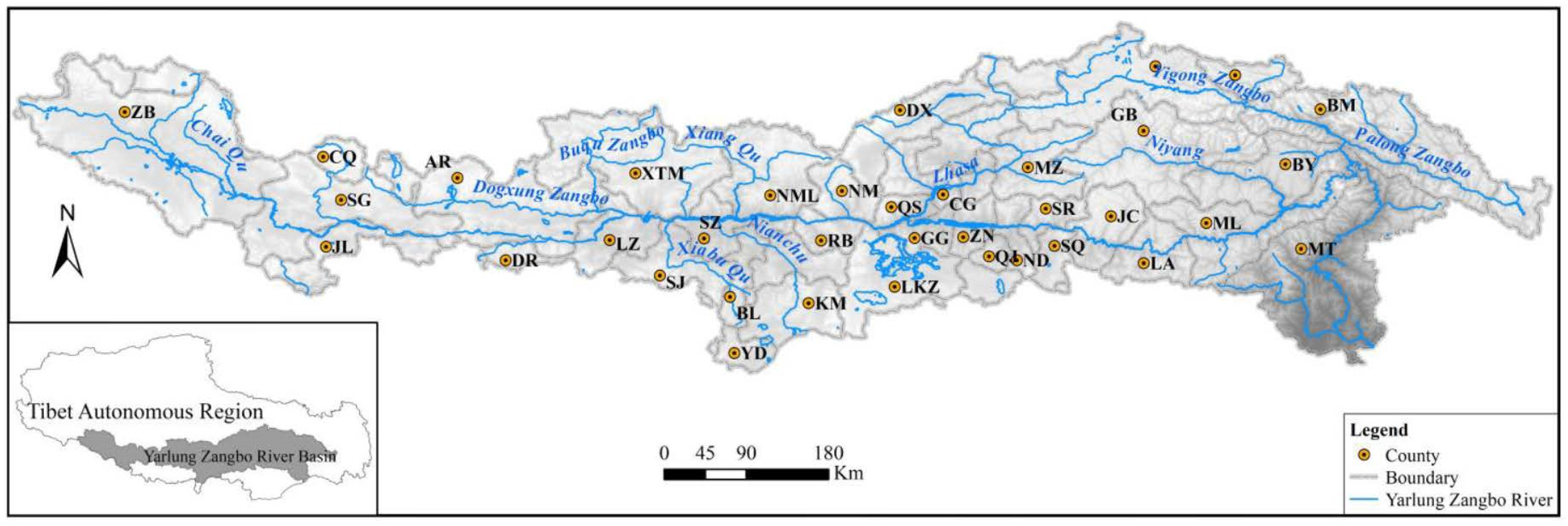

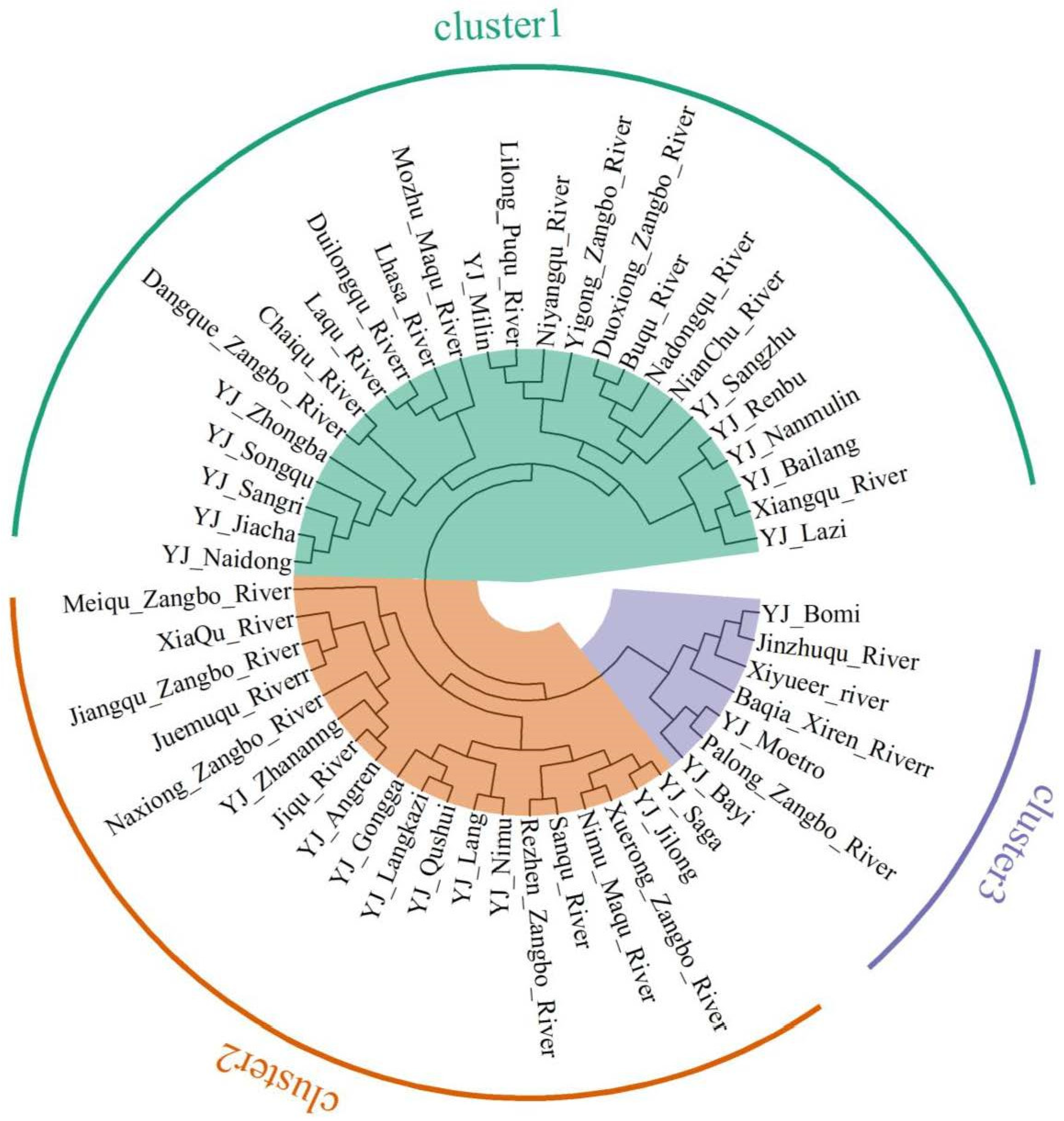
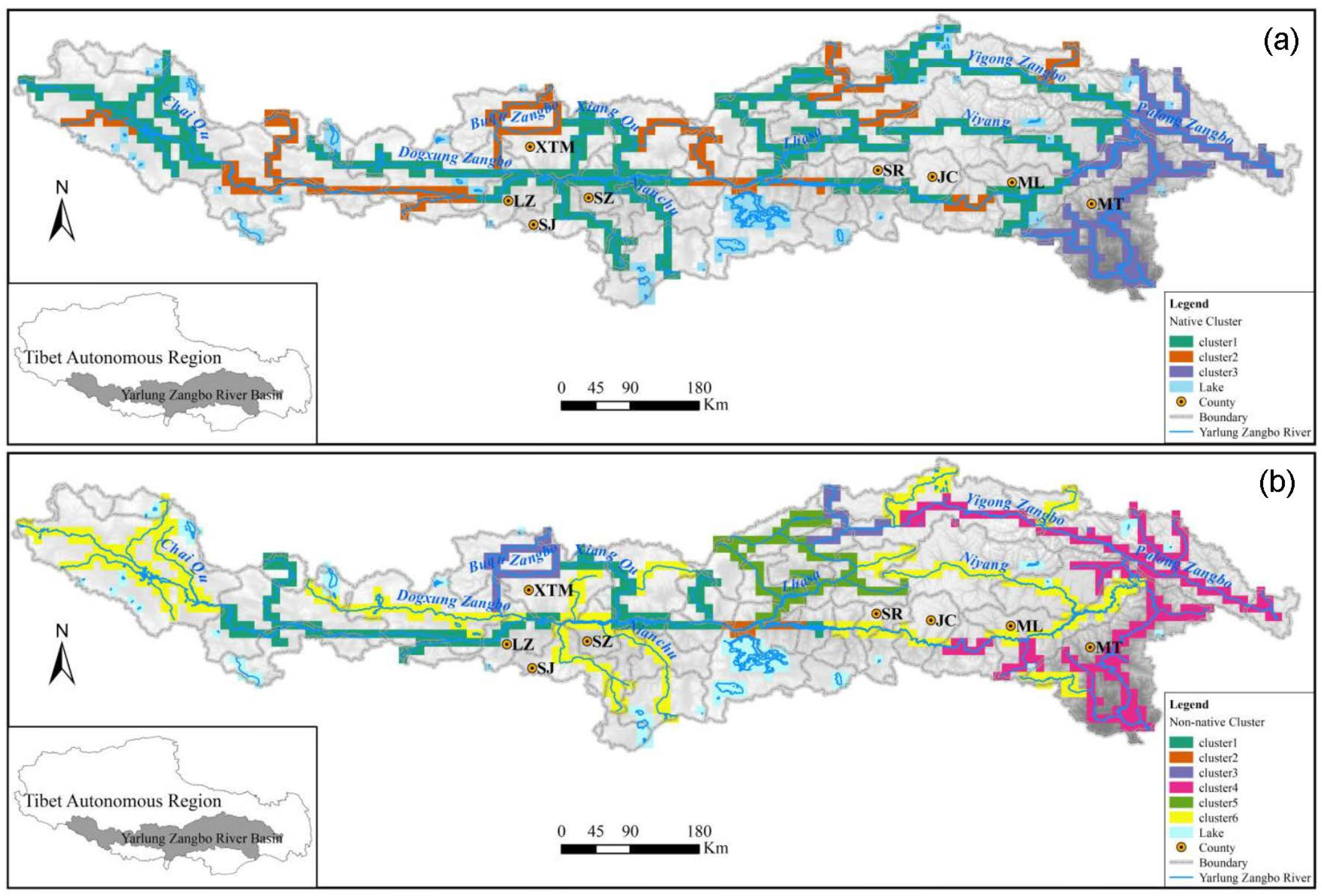


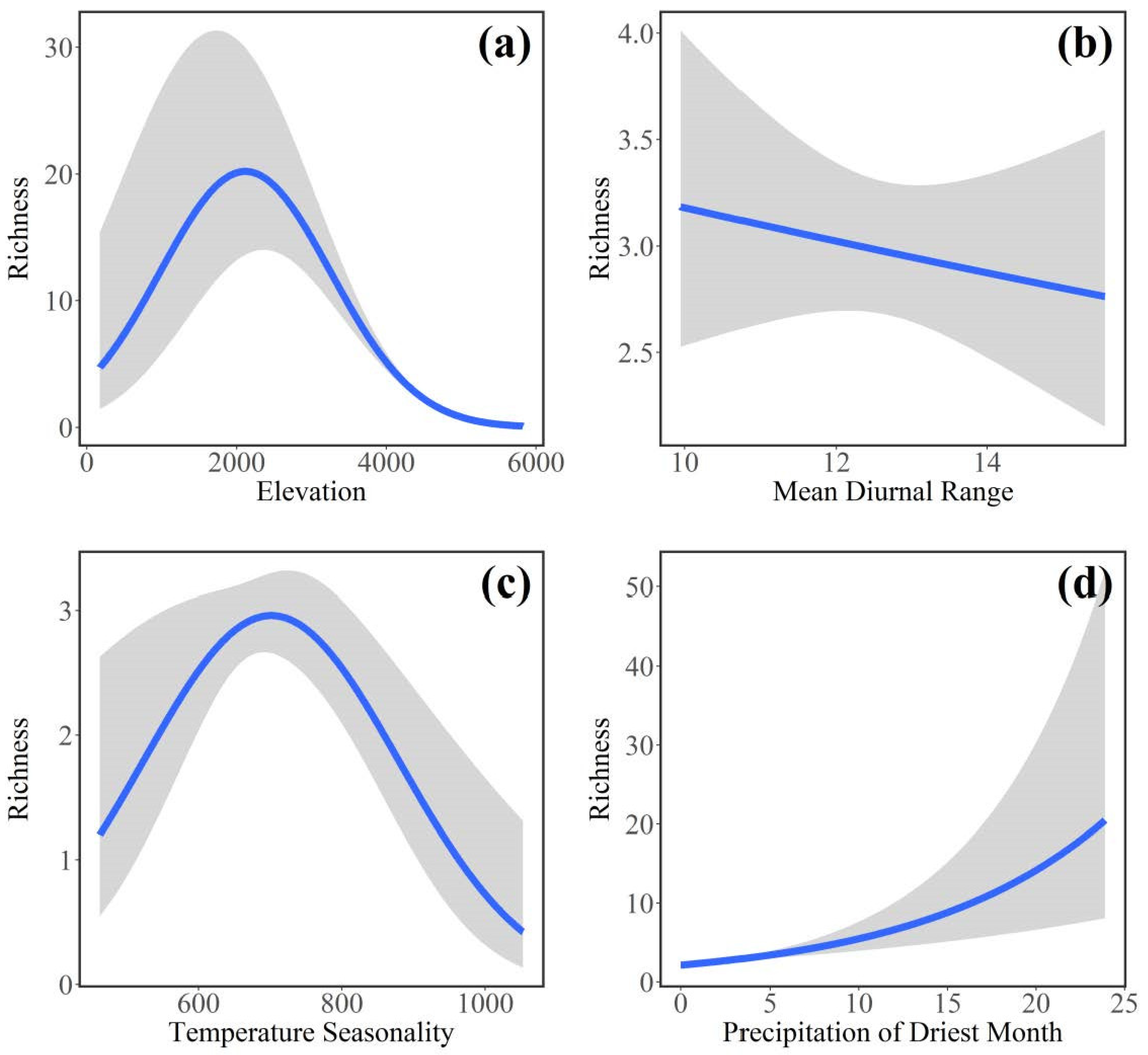
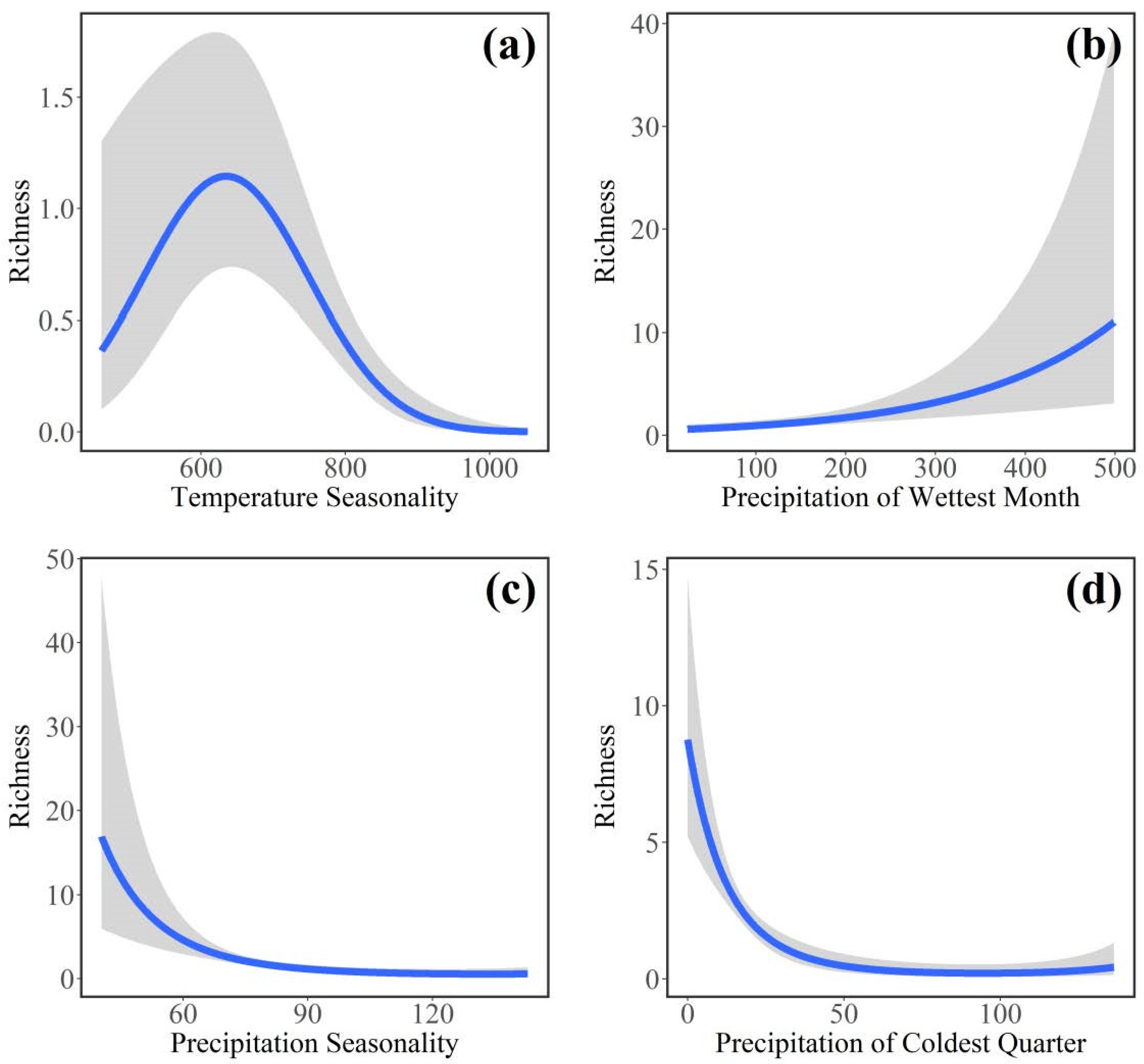
| Environmental Variable | Abbreviation |
|---|---|
| Annual mean temperature | Bio1 |
| Mean diurnal range | Bio2 |
| Isothermally | Bio3 |
| Temperature seasonality | Bio4 |
| Max temperature of warmest month | Bio5 |
| Min temperature of coldest month | Bio6 |
| Temperature annual range | Bio7 |
| Mean temperature of wettest quarter | Bio8 |
| Mean temperature of driest quarter | Bio9 |
| Mean temperature of warmest quarter | Bio10 |
| Mean temperature of coldest quarter | Bio11 |
| Annual precipitation | Bio12 |
| Precipitation of wettest month | Bio13 |
| Precipitation of driest month | Bio14 |
| Precipitation seasonality | Bio15 |
| Precipitation of wettest quarter | Bio16 |
| Precipitation of driest quarter | Bio17 |
| Precipitation of warmest quarter | Bio18 |
| Precipitation of coldest quarter | Bio19 |
| Water vapor pressure | Vapor |
| Elevation | Ele |
Publisher’s Note: MDPI stays neutral with regard to jurisdictional claims in published maps and institutional affiliations. |
© 2022 by the authors. Licensee MDPI, Basel, Switzerland. This article is an open access article distributed under the terms and conditions of the Creative Commons Attribution (CC BY) license (https://creativecommons.org/licenses/by/4.0/).
Share and Cite
Li, K.; Wang, J.; Wang, X.; Wang, M.; He, R.; Wang, M. Distribution Pattern of Fish Richness in the Yarlung Zangbo River Basin. Diversity 2022, 14, 1142. https://doi.org/10.3390/d14121142
Li K, Wang J, Wang X, Wang M, He R, Wang M. Distribution Pattern of Fish Richness in the Yarlung Zangbo River Basin. Diversity. 2022; 14(12):1142. https://doi.org/10.3390/d14121142
Chicago/Turabian StyleLi, Kai, Jishan Wang, Xiaoai Wang, Mengjun Wang, Ruchuan He, and Mo Wang. 2022. "Distribution Pattern of Fish Richness in the Yarlung Zangbo River Basin" Diversity 14, no. 12: 1142. https://doi.org/10.3390/d14121142
APA StyleLi, K., Wang, J., Wang, X., Wang, M., He, R., & Wang, M. (2022). Distribution Pattern of Fish Richness in the Yarlung Zangbo River Basin. Diversity, 14(12), 1142. https://doi.org/10.3390/d14121142







